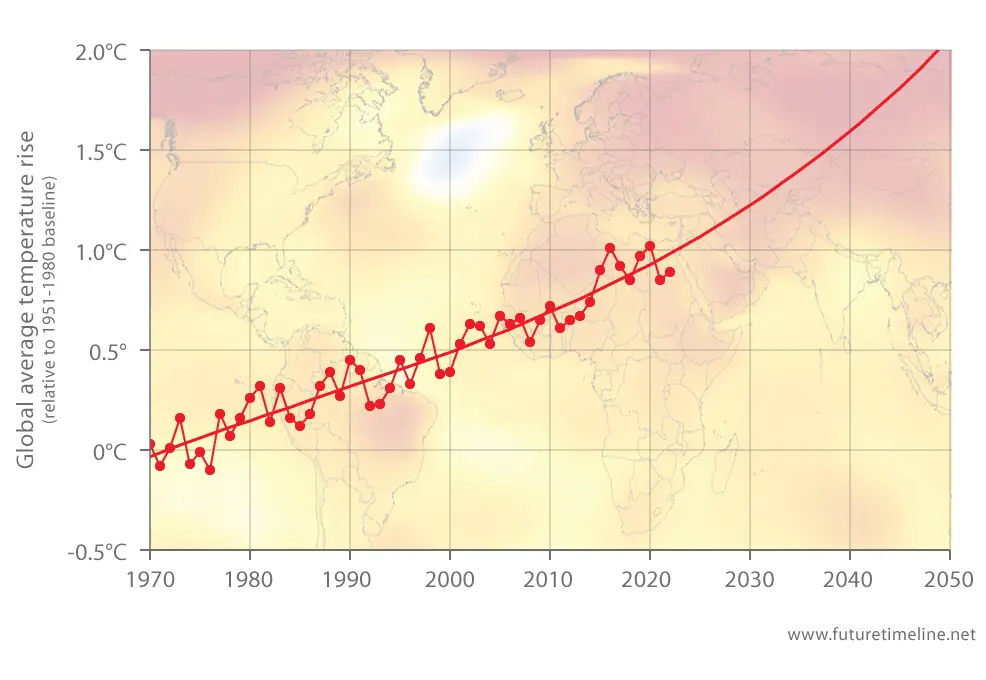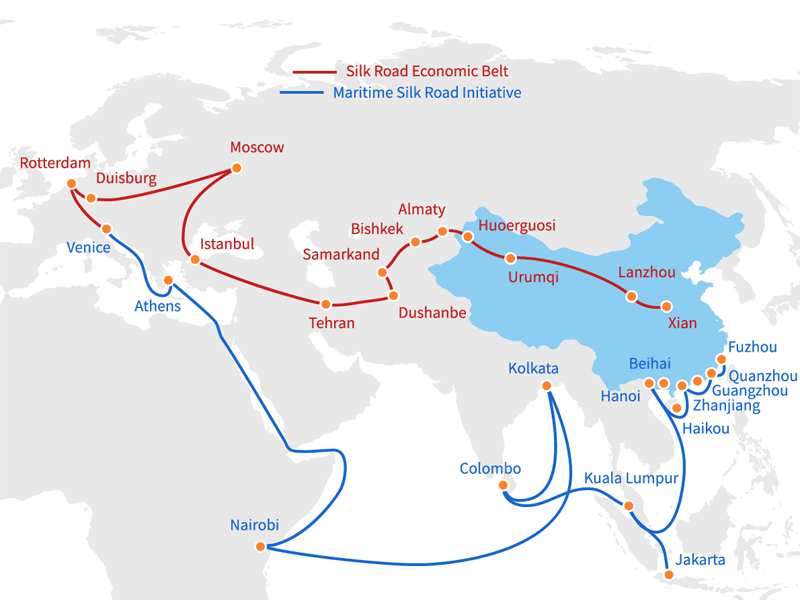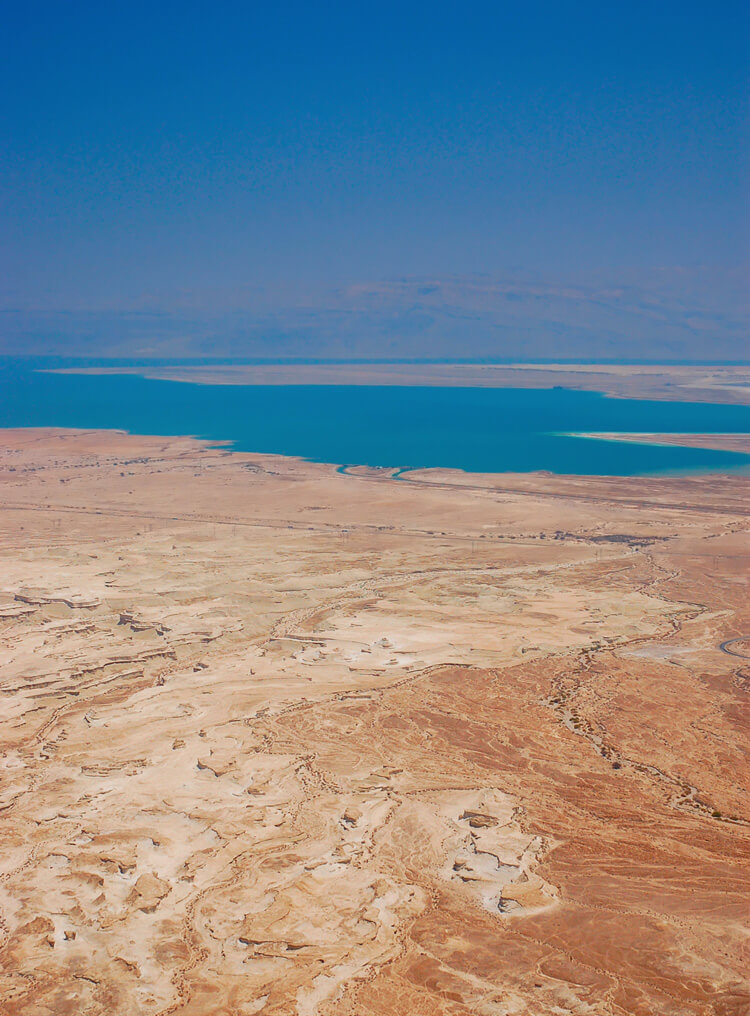
|
|
|
|
|
|
2049
Global warming reaches 2°C
Although many countries are now reaching their net zero goals, the global average temperature has continued to rise, due to the lag between emissions of carbon dioxide and their full effect on the climate. By 2049, the long-term average increase is at the critical threshold of 2°C, agreed in earlier treaties to be a limit beyond which severe and irreversible impacts may be expected.
Earth's climate system is now entering a new and more dangerous phase, with several tipping points being triggered. Among the most serious to be observed is a 40% slowdown in the Antarctic overturning circulation, due to meltwater pouring from land into the ocean around the icy continent. This deep ocean current – described as the "lungs of the ocean" – carries heat, carbon, oxygen, and nutrients around the globe, which in turn influences climate, sea level, and the productivity of ecosystems. Phytoplankton, for example, are a foundation for the marine food chain and depend on nutrient upwells, but the reduced circulation means a stagnation of waters, threatening their survival.*
In the Arctic, sea ice cover is now frequently non-existent during summer months.* The loss of these ice sheets, vital for reflecting sunlight back into space, means that Earth's temperature regulation has been seriously compromised. The reduced albedo has created a feedback cycle, in which dark ocean water is absorbing more sunlight, contributing to further global temperature increases. Greenland has been the fastest melting of all polar regions* and is now contributing to accelerated sea level rise, affecting coastal areas worldwide. Another tipping point at 2°C is a collapse of the Labrador Sea subpolar gyre, disrupting the transport of heat and freshwater in the North Atlantic.
Yet another tipping point underway is a dieback of significant portions of the Amazon rainforest.* At 2°C of global warming, this process is now beginning with a transition towards more open, savannah-like vegetation in many areas. Intensification of droughts and wildfires, and consequent disruption to rainfall patterns, has created a self-reinforcing feedback loop. Savannahs have less biodiversity compared to rainforests and store less carbon in their biomass and soils. This is reducing the Amazon's overall biodiversity and carbon storage capacity, with implications for global climate regulation.*
Compared to the 1.5°C of global warming reached in the 2030s, the percentage of the world's plants losing at least half of their habitable area has now doubled from 8% to 16%.* The percentage of insects losing at least half of their habitable area has tripled from 6% to 18%. Meanwhile, coral reefs have been almost completely wiped out, with losses increasing from 90% to 99%.

Data source: NASA GISTEMP
Extreme heatwaves are now a frequent and serious threat for many people. Compared to 1.5°C of global warming, the percentage of the world's population exposed to severe heat every one in five years has increased by 2.6 times, from 14% to 37%.*
In a related trend, the average length of a drought has now doubled, from two months at 1.5°C to four months at 2°C of warming. The population exposed to water scarcity has risen from 271m to 388m. Droughts classed as severe, which affected 133m in the 2030s, are now experienced by 195m. The lack of water is making it harder to tackle wildfires, which have increased by almost one-third globally* and by even more in some regions.
At the other end of the spectrum, the frequency of rainfall extremes over land has increased, rising by 17% at 1.5°C and now 36% at 2°C, relative to the start of the century. In parts of Asia, flooding is now catastrophic. The population affected by river flooding has jumped by substantial amounts in Bangladesh (546%), Bhutan (436%), and India (571%), relative to the start of the century.*
These impacts – and many others – have continued to increase the annual economic losses from weather-related events. The worldwide figure, which stood at $200 billion in 2020, has more than doubled to over $400 billion in 2049.* This is merely the long-term average trend, however. In particularly extreme years, the damages can exceed $0.5 trillion (adjusted for inflation).
By 2049, the magnitude of impacts is so great that almost every country has implemented a carbon pricing mechanism of some kind* – whether in the form of taxes, or cap and trade. These are set relative to income, putting pressure on wealthy individuals and corporations who have a disproportionate share of emissions compared to the rest of society. They also further incentivise the adoption of low-carbon technologies.
Other, more innovative solutions have emerged, such as carbon currencies or coins to reward the sequestering of carbon.** These "negative" emissions include the use of direct air capture (DAC) – now a multi-gigaton per year industry** – alongside natural methods like tree and soil restoration.
To prevent gaming of the system, a supranational authority has introduced regulations. This entity manages supply and demand, coordinates the operations of major central banks to give the carbon currency a guaranteed floor price, and independently verifies each ton of negative emissions. Standardised and reliable monitoring methods are now in place to ensure that carbon removal is genuine, facilitated by the Internet of Things and a widespread proliferation of devices like smart dust, robots, drones, and so on, able to report back in real time.
Environmental policies that once seemed impossible are finally coming to fruition, thanks to a combination of (a) the urgency of the situation, (b) clean tech now being vastly cheaper and more practical, and (c) the political influence of the Boomer generation having largely disappeared. The end of the fossil fuel era is therefore looming into view, appearing to require only a few more decades for the entire world to reach.
However, the sheer devastation wrought by 2°C of global warming threatens to destabilise the geopolitical order. In particular, the mass movement and resettlement of refugees has become a critical issue. Another high-priority subject for international negotiations is the demand by climate-vulnerable and developing nations for compensation – both from richer nations, and legacy fossil fuel companies for the damage their products have inflicted – but there are difficulties in building consensus.
Some countries are now resorting to desperate measures, such as the unilateral release of high-altitude balloons containing sulphur particles to trigger a climate cooling effect, with potentially unknown side effects. In the Middle East and parts of Asia, territorial and resource disputes are threatening to spill over into nuclear conflict.
Completion of China's Belt and Road Initiative
Chinese President Xi Jinping first proposed the Belt and Road Initiative (BRI) in 2013. Its purpose was to strengthen trade, infrastructure and investment links between China and more than 100 other countries spanning Eurasia, Africa, and Oceania.
One of the largest efforts of its kind in history, the BRI would comprise thousands of projects aiming to improve the lives of 4.4 billion people or about 60% of the global population, equal to 40% of the world's gross domestic product (GDP).
The Chinese government called the initiative "a bid to enhance regional connectivity and embrace a brighter future". However, some observers viewed it as a push for Chinese dominance in global affairs leading to a China-centered trading network. Having a targeted completion date of 2049,** it would coincide with the 100th anniversary of the People's Republic of China.
The BRI would have two main components – the Silk Road Economic Belt (SRB) and the Maritime Silk Road (MSR). The former was planned as a series of interconnecting infrastructure corridors passing through countries on the original Silk Road (established in the Han Dynasty) over Central Asia, West Asia, the Middle East and Europe. The Maritime Silk Road, by contrast, would consist of sea-based routes over several contiguous bodies of water: the South China Sea, South Pacific Ocean and wider Indian Ocean area.

Branching outwards from the main backbone of the SRB would be six subdivisions, forming links between major regions and coastlines. Like the tributaries of a major river, these consisted of: a New Eurasian Land Bridge; a China–Mongolia–Russia Corridor; a China–Central Asia–West Asia Corridor; a China–Indochina Peninsula Corridor; a Bangladesh–China–India–Myanmar (BCIM) Corridor; and a China–Pakistan Corridor.*
In addition to the SRB and MSR, Russia and China also worked jointly to build an "Ice Silk Road" along the Northern Sea Route in the Arctic, to facilitate increased resource extraction and cargo deliveries, as well as tourism and scientific opportunities.
China was already a world leader in infrastructure investment during the late 20th and early 21st century. In contrast with a general underinvestment in transport across much of the industrialised world, China had pursued major infrastructure-based development, resulting in engineering and construction expertise and a wide range of projects. The Belt and Road initiative was therefore a natural extension and continuation of this long-term strategy.
Five major priorities were defined for the BRI as a whole:
• Policy coordination
• Infrastructure connectivity
• Unimpeded trade
• Financial integration
• Connecting people
Over a period of 35 years, China would make several trillion dollars' worth of investments – in ports, airports, roads, railways (including high-speed routes), bridges and tunnels, as well as power plants and telecommunications networks.* One of the more notable examples included a clean energy "super grid", consisting of ultra-high voltage electricity networks linking China and much of the Asian continent.
However, while improving the flow of goods, services, people and capital in both developed and developing regions, the BRI programme was also criticised for being a debt burden on poorer countries; a form of neo-colonialism, which could leave them vulnerable to China's influence. Furthermore, a significant number of the infrastructure projects had proved to be "white elephants", lying empty and unused for years. The resulting bailouts placed the International Monetary Fund (IMF) under increasing pressure, torn between the competing interests of Washington and Beijing.
Despite these issues, the Belt and Road Initiative proved to be a success, overall – adding significantly to worldwide GDP and further cementing China's place as the leading global power of the mid-21st century.
The Dead Sea is drying up
The Dead Sea is a unique geological feature. Located between Israel and Jordan, it is the lowest point on Earth. With an extremely high content of mineral salts (20%), over six times greater than any ocean, it is completely devoid of life, except for extremophile bacteria. The salts are so concentrated that swimmers can float like corks, without using a life vest. The water of the sea is also purported to relieve pain and treat several different skin conditions and arthritis. For these reasons it has been a world famous tourist attraction.
By 2049, however, the sea has almost vanished. Its main supply of water – the River Jordan to the north – has seen extensive diversions for industry, agriculture and domestic use. This has reduced its flow to just a trickle by the time it reaches the Dead Sea, far from adequate to replace water lost by evaporation.
For decades, the Dead Sea had plummeted in depth, compounded by rising global temperatures accelerating the evaporation of water, and the growing population in the region. By 2049, little more than a pond remains. This is despite efforts to divert water from the Mediterranean and nearby Red Sea.*

The effects of heat stress on labour capacity have doubled
In the early years of the 21st century, peak summer months of heat stress were cutting human labour capacity to around 90 percent of its full potential. By the middle of the century, this figure has dropped to 80 percent.* Rising global temperatures are now having a major impact on those who work outside, or in hot environments – particularly in mid-latitude and tropical regions like South and East Asia, North America and Australia. This trend has occurred despite heavy reductions in man-made CO2 emissions.
Although robots are now handling many human roles, it nevertheless remains a serious issue for the economy and society in general. Heat stroke, heat exhaustion, heat cramps and other conditions are increasing the risk of accidents and injuries. Many sports and leisure activities are being abandoned due to excess heat and humidity, with people forced to spend more and more time indoors. This has boosted the appeal of virtual reality to replace the physical world.

Credit: U.S. Army
Neptune Odyssey makes orbital insertion
Neptune Odyssey is one of several missions to the so-called "ice giants" of the Solar System during the mid‑21st century. Launched in 2033, it undertakes a 16‑year cruise directly to Neptune, without gravity assists from other planets, making orbital insertion in 2049.*
An earlier spacecraft known as Trident had been a finalist for selection as a NASA Discovery-class mission in 2020, with a proposed launch date of 2025 and a 13‑day encounter with Neptune in 2038. In the end, however, Trident lost out to DAVINCI and VERITAS, a pair of missions to Venus.
Neptune Odyssey emerged as a more ambitious, longer-term concept for NASA – a logical successor to earlier flagship orbiters at Jupiter, Saturn, and Uranus – developed by scientists from the Applied Physics Laboratory of Johns Hopkins University.
Unlike the relatively brief mission proposed for Trident, this would involve a much longer stay at Neptune and its moons, with a spacecraft performing science operations for four years between 2049 and 2053. While Trident had included only six instruments, Neptune Odyssey packed a total of 22 – with 14 on the main spacecraft and a further eight on a separate atmospheric probe – allowing it to form the most comprehensive and detailed picture of the planet ever obtained. Weighing 3,200 kg (7,090 lb) and powered by 1.1 kilowatts from radioisotope thermoelectric generators, Odyssey would measure a wide array of chemical and physical processes occurring in and around Neptune, as well as returning high-resolution imagery.
Odyssey begins its approach to Neptune on 4th May 2049, injecting into an elliptical orbit on 3rd June 2049. To achieve its elliptical orbit, the flight system executes a 3,400 km/h (2,100 mph) manoeuvre with a closest approach of 2,000 km above Neptune, resulting in an orbit with a period of 214 days. At the point of lowest altitude, the orbiter releases a small atmospheric probe that descends for around 37 minutes into Neptune's upper atmosphere to study its composition, dynamics, and processes, sending data at least until reaching a pressure of 10 bars (about 10 Earth atmospheres).
For the next four years, the orbiter studies Neptune and its moons, including Triton – notable as one of the coldest places in the Solar System, with an estimated surface temperature of -235 °C (-391 °F, 38 K). While the Voyager 2 mission of 1989 mapped only 40% of Triton, Odyssey conducts at least 46 flybys of Triton with vastly higher image resolution, achieving near-global coverage of the moon.
Ice giants like Uranus and Neptune are thought to be common throughout the Milky Way galaxy, so the data from Odyssey can be used as an analogue to better understand similar exoplanets, providing an enhanced knowledge of planetary formation and the potential habitability of other systems. The mission also determines the cause of Neptune's strange magnetic field, revealing how its magnetosphere and aurorae work. Connections are found between Neptune's rings, arcs, surface weathering, and small moons.
Other mysteries answered by the probe include whether Triton has an ocean below its surface, what causes its plumes, and the nature of its atmosphere. A more detailed picture of the moon's geophysics and composition helps to expand the knowledge of dwarf planets like Pluto.
The Boeing 747 is retired from service
In the 1960s, US airline Pan Am sought to introduce a new and much larger aircraft than any previously operated. Foreseeing the enormous, long-term growth potential of air travel, the company wanted a jet 2½ times the size of the 707 series, to lower seat costs by 30% and to democratise aviation.
Aerospace company Boeing started work on the 747, the first twin aisle airliner, with Pan Am ordering 25 planes. A first flight occurred in February 1969 and it entered service with Pan Am in January 1970; the first plane dubbed a "Jumbo Jet".
Development of the 747 continued over the decades, leading to new variants with even larger sizes, more powerful engines, longer flight ranges and greater seating capacities. The final 747–8 featured a wingspan of 68.4 m (224 ft), length of 76.25 m (250 ft), a range of 14,320 km (7,730 nautical miles), and seats for 467 passengers in a typical three-class configuration.
With its huge dimensions, this giant of the skies became an icon of the late 20th century. In addition to being a civilian aircraft, the 747 served as the basis for government and military variants, and experimental testbeds like the Shuttle Carrier. Annual orders peaked in 1990 with 122 new planes. The 747 remained the world's largest passenger aircraft for 37 years, until the Airbus A380 superjumbo, which had its maiden commercial flight with Singapore Airlines in 2007.
However, major changes began to occur in the industry, which became increasingly apparent during the 21st century. Airline operators gradually shifted their preference away from very large aircraft (VLA) and towards smaller, more fuel-efficient planes with more flexibility and lower upfront costs.
Delta Air Lines retired the last U.S. passenger Boeing 747 in December 2017, after the plane had flown for every major carrier since 1970. While more than 450 remained in service globally by the end of the decade – with Atlas Airlines and British Airways being the largest operators – a growing proportion of 747 orders had gone to freighter, as opposed to passenger variants.
In July 2020, media reports revealed that Boeing intended to end production of the 747 series, after delivery of its 16 outstanding orders. Production of the final aircraft would occur in 2022.* While no longer a mainstay of passenger flights, it remained popular for delivering cargo, thanks to its huge capacity.* The 747 series had been able to endure about 35,000 pressurisation cycles and flights – up to 165,000 flight hours – before metal fatigue. Given its lifetime of 27 years, this would mean service ending in the late 2040s.* It joins the B-52 Stratofortress, another massive Boeing aircraft, also retiring this decade.
New and extremely hi-tech aircraft are now replacing the older generations, with major advances in travel comfort, further improvements in efficiency and a great reduction in journey times.*

The Fukushima disaster is cleaned up
The Fukushima Daiichi nuclear disaster was a catastrophic failure at a Japanese nuclear power station on 11th March 2011,* resulting in a meltdown of three of the plant's six nuclear reactors. It occurred when the plant was struck by a tsunami triggered by the Tōhoku earthquake. Substantial amounts of radioactive materials began to leak, creating the largest nuclear incident since the Chernobyl disaster in April 1986 and the second (after Chernobyl) to measure Level 7 on the International Nuclear Event Scale.
Although no short term radiation exposure fatalities were reported, some 300,000 people were forced to evacuate the area, nearly 16,000 died in the earthquake and tsunami, and 1,600 deaths resulted from evacuation conditions, such as living in temporary housing and hospital closures. The disaster prompted some countries to re-evaluate their policies on nuclear energy. Germany and Switzerland, for example, abandoned this technology altogether, shutting down their last remaining plants in 2023 and 2034, respectively.
In the wake of the plant meltdowns, a huge cleanup and decommissioning process was initiated. This presented enormous challenges, with massive amounts of radioactive water spilling out – some finding its way into the Pacific (along with debris*) and even reaching as far as the U.S. West Coast.* Methods used to contain this water included a frozen underground barrier, with coolant fed into pipes at -30°C (-22°F). Robots were required in some parts of the facility, as radiation levels were often too high for humans. In 2014, it was estimated that sealing every reactor off would cost tens of billions of dollars, taking 30-40 years. Sure enough, by the end of the 2040s, this operation is finally reaching its conclusion.*

« 2048 |
⇡ Back to top ⇡ |
2050 » |
If you enjoy our content, please consider sharing it:
References
1 Antarctic ocean heading for "collapse" by 2050, Future Timeline Blog:
https://www.futuretimeline.net/blog/2023/04/5-antarctic-ocean-collapse-2050.htm
Accessed 30th April 2023.
2 Observed and projected decline in Arctic sea-ice area, European Environment Agency:
https://www.eea.europa.eu/data-and-maps/figures/observed-and-projected-decline-in-2
Accessed 30th April 2023.
3 Mass balance of the Greenland and Antarctic ice sheets from 1992 to 2020, Earth System Science Data:
https://essd.copernicus.org/articles/15/1597/2023/
Accessed 30th April 2023.
4 World on brink of five 'disastrous' climate tipping points, study finds, The Guardian:
https://www.theguardian.com/environment/2022/sep/08/world-on-brink-five-climate-tipping-points-study-finds
Accessed 30th April 2023.
5 Tipping points in the climate system, Wikipedia:
https://en.wikipedia.org/wiki/Tipping_points_in_the_climate_system
Accessed 30th April 2023.
6 What's the difference between 1.5 and 2 degrees of global warming?, World Economic Forum:
https://www.weforum.org/agenda/2021/07/2c-global-warming-difference-explained/
Accessed 30th April 2023.
7 What's the difference between 1.5 and 2 degrees of global warming?, World Economic Forum:
https://www.weforum.org/agenda/2021/07/2c-global-warming-difference-explained/
Accessed 30th April 2023.
8 Wildfires likely to increase by a third by 2050, warns UN, The Guardian:
https://www.theguardian.com/environment/2022/feb/23/climate-crisis-driving-increase-in-wildfires
Accessed 30th April 2023.
9 The impacts of climate change at 1.5C, 2C and beyond, Carbon Brief:
https://interactive.carbonbrief.org/impacts-climate-change-one-point-five-degrees-two-degrees/
Accessed 30th April 2023.
10 Economic losses from weather-related events, 1970-2060, Future Timeline Data & Trends:
https://www.futuretimeline.net/data-trends/22-global-warming-future-insurance-trend.htm
Accessed 30th April 2023.
11 See 2046.
12 A Carbon Currency based on Carbon Allowances, YouTube:
https://www.youtube.com/watch?v=grpATPBjurE
Accessed 30th April 2023.
13 The Ministry for the Future, Wikipedia:
https://en.wikipedia.org/wiki/The_Ministry_for_the_Future
Accessed 30th April 2023.
14 "In the longer term, analysis shows that direct air capture could be a multi-gigaton per year industry by the 2040s."
See World's largest direct air capture and CO2 storage plant begins operations, Future Timeline Blog:
https://www.futuretimeline.net/blog/2021/09/11-future-direct-air-capture.htm
Accessed 30th April 2023.
15 CO2 removal needs 1,300x increase by 2050, Future Timeline Blog:
https://www.futuretimeline.net/blog/2023/01/20-carbon-capture-2050.htm
Accessed 30th April 2023.
16 Belt and Road Initiative, Wikipedia:
https://en.wikipedia.org/wiki/Belt_and_Road_Initiative
Accessed 3rd May 2019.
17 CrowdReviews Partnered with Strategic Marketing & Exhibitions to Announce: One Belt, One Road Forum, PR.com:
https://www.pr.com/press-release/780645
Accessed 3rd May 2019.
18 How China is redrawing the map of world science, Nature:
https://www.nature.com/immersive/d41586-019-01124-7/index.html
Accessed 3rd May 2019.
19 What is the Belt and Road initiative? | CNBC Explains, YouTube:
https://www.youtube.com/watch?v=ACbbz0rOv6A
Accessed 3rd May 2019.
20 Dead Sea may dry out completely by 2050, The Times of India:
http://timesofindia.indiatimes.com/home/environment/global-warming/Dead-Sea-may-dry-out-completely-by-2050-/articleshow/5268324.cms
Accessed 9th October 2010.
21 New NOAA study estimates future loss of labor capacity as climate warms, The National Oceanic and Atmospheric Administration (NOAA):
http://www.noaanews.noaa.gov/stories2013/20130225_laborandclimate.html
Accessed 3rd March 2013.
22 Neptune Odyssey, NASA:
https://smd-cms.nasa.gov/wp-content/uploads/2023/05/NeptuneOdyssey.pdf
Accessed 22nd April 2024.
23 Boeing to quietly stop the 747 program, closing era of jumbo jets, AIRLIVE.net:
https://www.airlive.net/boeing-to-quietly-stop-the-747-program-closing-era-of-jumbo-jets/
Accessed 4th July 2020.
24 As airlines say goodbye to the legendary Boeing 747 early, the plane still plays a vital role for cargo carriers and is aiding efforts to defeat COVID-19, Business Insider:
https://www.businessinsider.com/boeing-747-resurgence-in-cargo-as-passenger-airlines-retire-2020-3
Accessed 4th July 2020.
25 How Are Planes Decommissioned, and How Much Value Can Be Salvaged From Their Parts?, Flexport:
https://www.flexport.com/blog/decommissioned-planes-salvage-value/
Accessed 4th July 2020.
26 See 2050.
27 See 2011.
28 Trash talk, or charting marine debris, University of Hawaiʻi at Mānoa [2014].
29 Japan Fukushima Radiation Reaching West Coast?, Guardian Liberty Voice:
http://guardianlv.com/2014/04/japan-fukushima-radiation-reaching-west-coast/
Accessed 14th July 2014.
30 "Obviously, it's difficult to say for sure how many years it's going to take … at the moment we're talking about 30 or 40 years."
See Doubts over ice wall to keep Fukushima safe from damaged nuclear reactors, The Guardian:
http://www.theguardian.com/environment/2014/jul/13/doubts-giant-ice-wall-fukushima-nuclear-reactors
Accessed 14th July 2014.
![[+]](https://www.futuretimeline.net/images/buttons/expand-symbol.gif)






